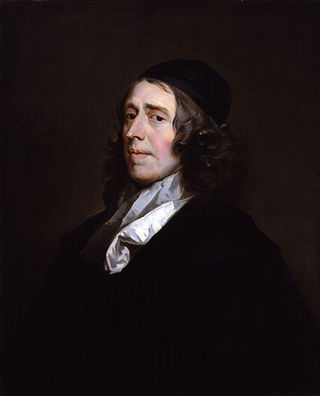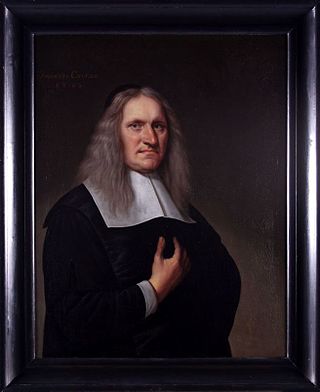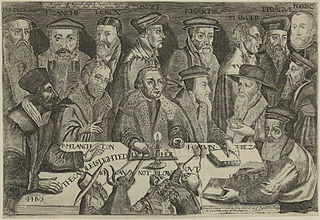
Calvinism, also called Reformed Christianity, is a major branch of Protestantism that follows the theological tradition and forms of Christian practice set down by John Calvin and various other Reformation-era theologians. It emphasizes the sovereignty of God and the authority of the Bible.

John Owen was an English Nonconformist church leader, theologian, and academic administrator at the University of Oxford.

Philips of Marnix, Lord of Saint-Aldegonde, Lord of West-Souburg was a Flemish and Dutch writer and statesman, and the probable author of the text of the Dutch national anthem, the Wilhelmus.
The Dutch Reformed Church was the largest Christian denomination in the Netherlands from the onset of the Protestant Reformation in the 16th century until 1930. It was the original denomination of the Dutch royal family and the foremost Protestant denomination until 2004. It was the larger of the two major Reformed denominations, after the Reformed Churches in the Netherlands was founded in 1892. It spread to the United States, South Africa, Indonesia, Sri Lanka, Brazil, and various other world regions through Dutch colonization. Allegiance to the Dutch Reformed Church was a common feature among Dutch immigrant communities around the world and became a crucial part of Afrikaner nationalism in South Africa.

Gisbertus Voetius was a Dutch Calvinist theologian.

Johannes Cocceius was a Dutch theologian born in Bremen.

Anna Maria van Schurman was a Dutch painter, engraver, poet, classical scholar, philosopher, and feminist writer who is best known for her exceptional learning and her defence of female education. She was a highly educated woman, who excelled in art, music, and literature, and became a polyglot proficient in fourteen languages, including Latin, Ancient Greek, Biblical Hebrew, Arabic, Syriac, Aramaic, and Ethiopic, as well as various contemporary European languages. She was the first woman to unofficially study at a Dutch university.

Calvinism originated with the Reformation in Switzerland when Huldrych Zwingli began preaching what would become the first form of the Reformed doctrine in Zürich in 1519.

Wilhelmus à Brakel, also known as "Father Brakel", was a Reformed minister and theologian in the Netherlands. He was a contemporary of Gisbertus Voetius and Hermann Witsius and a major representative of the Dutch Further Reformation.
The Second Reformation was an evangelical campaign from the 1820s onwards, organised by theological conservatives in the Church of Ireland and Church of England.

The reign of King James I of England (1603–1625) saw the continued rise of the Puritan movement in England, that began during reign of Queen Elizabeth (1558–1603), and the continued clash with the authorities of the Church of England. This eventually led to the further alienation of Anglicans and Puritans from one another in the 17th century during the reign of King Charles I (1625–1649), that eventually brought about the English Civil War (1642–1651), the brief rule of the Puritan Lord Protector of England Oliver Cromwell (1653–1658), the English Commonwealth (1649–1660), and as a result the political, religious, and civil liberty that is celebrated today in all English speaking countries.

Arminianism was a controversial theological position within the Church of England particularly evident in the second quarter of the 17th century. A key element was the rejection of predestination. The Puritans fought against Arminianism, and King James I of England opposed it before, during, and after the Synod of Dort, 1618–1619, where the English delegates participated in formulating the Calvinist Canons of Dort, but his son Charles I, favoured it, leading to deep political battles. The Methodists, who espoused a variant of the school of thought called Wesleyan–Arminian theology, branched off the Church of England in the 18th century.

Andreas Essenius was a Dutch Reformed theologian, controversialist and academic. He became professor of theology at the University of Utrecht.
Joel Robert Beeke is an American Reformed theologian who is a pastor in the Heritage Reformed Congregations and the chancellor of Puritan Reformed Theological Seminary. Under the oversight of the Heritage Reformed Congregations, Beeke helped found Puritan Reformed Theological Seminary in 1995, where he served as president until he assumed the chancellorship in 2023. He teaches there as the professor of homiletics, systematic theology, and practical theology. Beeke has also taught as adjunct faculty at Reformed Theological Seminary and Grand Rapids Theological Seminary ; he was an adjunct professor of theology at Westminster Theological Seminary in Philadelphia, Pennsylvania, from 1993 to 1998; he lectured in homiletics at Westminster Seminary California in Escondido, California from 1995 to 2001; and he has lectured at dozens of seminaries around the world.

Johann Cloppenburg was a Dutch Calvinist theologian. He is known as a controversialist, and as a contributor to federal theology. He also made some detailed comments on the moral status of financial and banking transactions.

Historians have produced and worked with a number of definitions of Puritanism, in an unresolved debate on the nature of the Puritan movement of the 16th and 17th century. There are some historians who are prepared to reject the term for historical use. John Spurr argues that changes in the terms of membership of the Church of England, in 1604–6, 1626, 1662, and also 1689, led to re-definitions of the word "Puritan". Basil Hall, citing Richard Baxter. considers that "Puritan" dropped out of contemporary usage in 1642, with the outbreak of the First English Civil War, being replaced by more accurate religious terminology. Current literature on Puritanism supports two general points: Puritans were identifiable in terms of their general culture, by contemporaries, which changed over time; and they were not identified by theological views alone.
Reformed orthodoxy or Calvinist orthodoxy was an era in the history of Calvinism in the 16th to 18th centuries. Calvinist orthodoxy was paralleled by similar eras in Lutheranism and tridentine Roman Catholicism after the Counter-Reformation. Calvinist scholasticism or Reformed scholasticism was a theological method that gradually developed during the era of Calvinist Orthodoxy.

Petrusvan Mastricht was a Reformed theologian.

Simon Oomius or Ooms was a Dutch reformed minister and theologian. He played an important role in the Nadere Reformatie.














